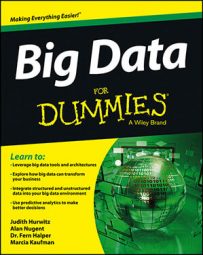The big data that can make a difference in how companies satisfy their customers and partners is not necessarily in traditional databases any more. The value of unstructured data from nontraditional sources has become apparent. Business leaders have discovered that if they can quickly analyze information that is unstructured — either in the form of text from customer support systems or social media sites — they can gain important insights.
How big data analytics makes companies agile and profitable
When companies can analyze massive collections of data and compare those results in real time to the customer decision-making process, businesses can gain huge revenue increases. Therefore, leveraging a combination of unstructured and structured data as part of a business process can transform a business's capability to be agile and nimble, and most importantly, profitable.
Many companies accumulate huge amounts of unstructured data that have been underused as sources of information about their customer experience. Unstructured data is the text found in e-mails, text messages, call center notes, comments in survey responses, tweets, and blogs. This type of data represents about 80 percent of the data available to companies, and it is continuing to grow.
Unstructured data has typically taken many manual hours to review, and in many companies, it has never have been adequately analyzed. Companies recognize that if this data is analyzed at the right time, it may help to identify patterns of customer dissatisfaction or a potential product defect so that corrective action can be taken before it is too late.
The increasing sophistication of text analytics is viewed by companies as a major benefit, enabling the deep analysis of large volumes of unstructured data in real or near real time so that the results can be used in decision making. Text analytics is the process of analyzing unstructured text, extracting relevant information, and transforming it into structured information that can be leveraged in various ways.
Using big data and text analytics to improve responsiveness
Understanding the mechanics of text analytics is fine, but how would this work in the real world? Look at an example of a car rental company that was experiencing huge pressures from emerging companies that didn't have the same high overhead. How could the existing company compete? Improving responsiveness seemed to be the key to success.
Therefore, the company was able to use text analytics to begin making significant improvements in its customer service. The company encouraged its customers to provide feedback on its services in online surveys or by e-mail or text. Customers used these communication methods to provide comments about service issues such as longer-than-expected wait times, poor agent service, or not getting the car they ordered.
However, the company's response and interpretation of these comments had been inconsistent. The company was taking the right approach, but the response was too slow and the analysis was inconsistent. Agency managers read the e-mails and comments in web surveys and text messages. Managers read the comments online and placed them in categories for future attention.
Unfortunately, this approach took a long time, and each manager followed a different approach to categorizing comments. It was too easy to miss patterns of dissatisfaction or concern that might show up if you were able to look across a large number of comments at one time.
What managers wanted to do was analyze feedback from customers faster so that they could identify potential issues in real time and address problems at the outset before they become bigger problems.
Managers implemented a text analytics solution that allowed them to quickly analyze text for insight across all types of sources, including structured and unstructured data. They also implemented a sentiment analysis solution that enabled an automated approach to identifying forms of communication that might need immediate attention. They were able to capture large volumes of information about the customer experience in real time and quickly analyze and take action.
The company was able to make major improvements in customer satisfaction. It is able to keep better track of car and equipment rental performance levels and find problems and fix them early. It now has a more accurate understanding of where problems are located and can recognize them much faster. The new analysis provided managers with an early identification of problems at one location.
As a result, they were able to make changes and improve customer satisfaction at this location.

